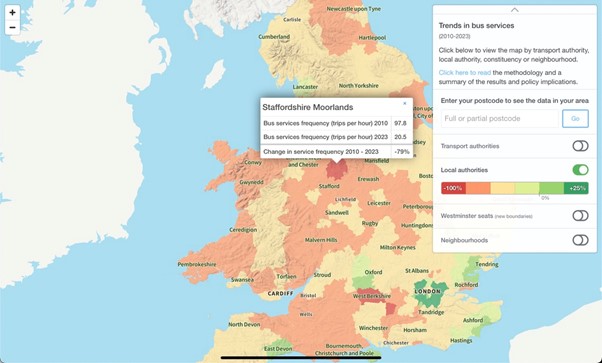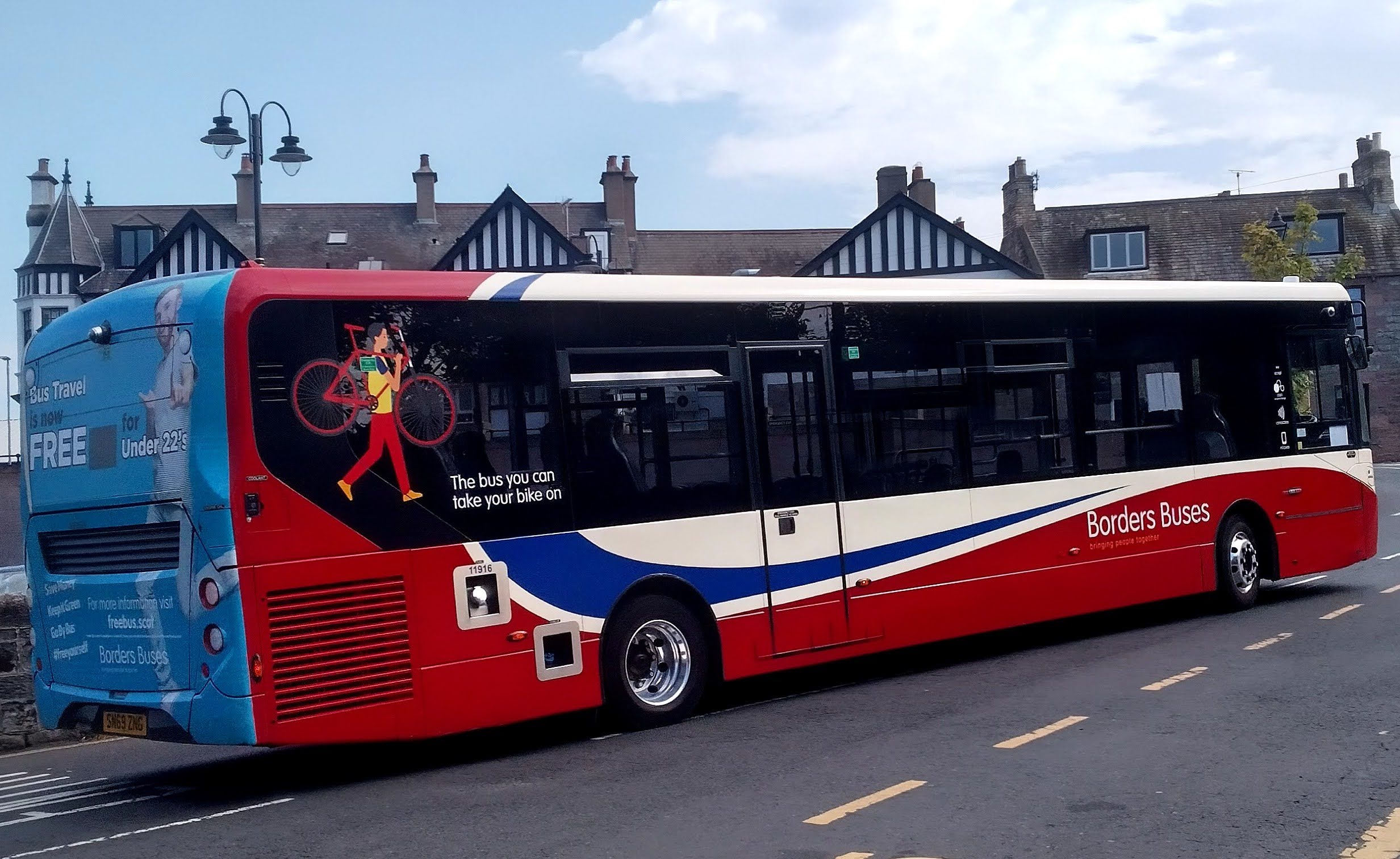
We've been thrilled to see that the area covered by Moorlands Connect has been extended and there's a new scheduled Sunday service from Leek to Buxton, taking in the tourist hotspots along the way. However, we understand that there are still some problems with the app, which is outside of the bus company's direct control. So, do ring them if the app doesn't work for you.
We're still running our public survey to try to augment our understanding of the barriers to usage and have been taking it to all our public events. If you haven't yet had a chance to complete it, you can do it online, so do please take part if you haven't already done so or even if you haven't used the service. Your reasons for not doing so will still be informative. Even better, share it with your friends. Thanks!

The County Council came to the Moorlands in April to explain the Ten-Year Transport Review to councillors, specifically to talk about buses. Four officers made the trek from Stafford to the land that public transport (almost) forgot and we have to admit that they came impressively prepared with facts and figures. At times it felt like being a housewife (it was always a housewife) in 1970’s Leningrad – scanning the shelves for that elusive bunch of bananas or, if they were lucky, grapes. If the County cupboard wasn’t completely bare, it has to be said the pickings were scarce. Most County bus money is spent on propping up existing services on which, as across most of the country, passenger numbers have not fully recovered from the Covid epidemic. But like that Leningrad housewife, we do not give up – and know that in times of scarcity, information is the most precious commodity.
The April meeting was arranged by Cllrs Charlotte Atkins and Mark Johnson as an introduction but the County officers and have said they will be returning to the Moorlands in June or July. At that point we might be able to put more detailed proposals forward to the County. While we can’t expect a major shift towards buses, we definitely can achieve some improvements at the edges. A new service now connects Biddulph and Kidsgrove, allowing people (including students) to link with rail services into Stoke and elsewhere. The officers said that numbers using this service were encouraging – and still rising.
 This is a crucial year for buses in the Moorlands. The County’s 10-year Transport Plan Review started publicly in January and is scheduled to be completed by the end of the year. The County had previously failed to attract additional funding for buses from central government because its previous Bus Improvement Strategy was deemed inadequate. Alongside this, the County is waiting for confirmation (expected in April) of extra new money from Network North from the cancellation of HS2.
This is a crucial year for buses in the Moorlands. The County’s 10-year Transport Plan Review started publicly in January and is scheduled to be completed by the end of the year. The County had previously failed to attract additional funding for buses from central government because its previous Bus Improvement Strategy was deemed inadequate. Alongside this, the County is waiting for confirmation (expected in April) of extra new money from Network North from the cancellation of HS2.
Many people complain about the poor level of bus services, but without a proper case being put to the County it is unlikely that we will see substantial extra investment in our district. SMDC Councillor Charlotte Atkins has now written to the County asking that officers come to the Moorlands to hear our case. She has since received agreement that there will be a meeting in the district for just that purpose. The date, precise location and nature of that meeting has yet to be set, but this is a step forward from previous years when, despite promises of a ‘rural bus revolution’ there was little tangible evidence of any detailed engagement except on the subject of Moorlands Connect.
Buses are crucial in the push for decarbonisation of the district. With the growth in car use, and the rapid growth in renewables in the UK’s energy generation system, transport is now the stand-out component of the country’s emissions profile. The decline in bus services has been more severe in Staffordshire Moorlands than almost anywhere else in England, as the accompanying map from the University of Leeds/Transport Action Network dramatically illustrates.
The central role of buses in decarbonisation was underlined by County officers when they introduced the 10-year Transport Review. This is a summary of what they said:
 Recently, MCA members caught a bus to take themselves and all their stall kit to the Sustainability Summit at Stoke-on-Trent. The ride only took a little longer than a car journey and was less stressful: we had no parking problem at the other end, enjoyed talking to passengers along the way and got a bit of healthy exercise walking to and from the bus station in Leek. The downside, of course, was that we had to get back before the buses stopped running and couldn’t stay for a celebratory pizza. Also, in the absence of an integrated bus system, we had to pay twice for the two bus legs in each direction, even though the connection was pretty seamless. In this respect, we envy the citizens of Greater Manchester with their Bee Network, where the buses are under local control.
Recently, MCA members caught a bus to take themselves and all their stall kit to the Sustainability Summit at Stoke-on-Trent. The ride only took a little longer than a car journey and was less stressful: we had no parking problem at the other end, enjoyed talking to passengers along the way and got a bit of healthy exercise walking to and from the bus station in Leek. The downside, of course, was that we had to get back before the buses stopped running and couldn’t stay for a celebratory pizza. Also, in the absence of an integrated bus system, we had to pay twice for the two bus legs in each direction, even though the connection was pretty seamless. In this respect, we envy the citizens of Greater Manchester with their Bee Network, where the buses are under local control.
Clearly, the Moorlands isn’t Manchester but there’s a lot of traffic running between Leek and Hanley, even at night. The loss of late services makes teenagers who live along the route dependent on their parents for travel to social engagements. Do parents wait at their destinations or do they do the journey twice, with all that that entails? Similarly, many older people don’t enjoy driving at night but would happily take the bus. It’s an unfortunate fact that the scarcity of buses restricts educational and employment opportunities, particularly for the young. Perhaps there’s scope for putting pressure on the bus companies? Do let us know if you agree, via
 Should we expect the County to spend our council tax shovelling air around the district? In our last issue, we encouraged our readers to get out and about via Moorlands Connect. We were concerned then that an underused service would likely be discontinued and now we know that current funding for the service will very likely run out in 18 months’ time.
Should we expect the County to spend our council tax shovelling air around the district? In our last issue, we encouraged our readers to get out and about via Moorlands Connect. We were concerned then that an underused service would likely be discontinued and now we know that current funding for the service will very likely run out in 18 months’ time.
Sadly, we understand that the current cost per passenger to the county is £25, caused by the low take up of the service and the logistics of running in a rural area. The threshold for continuing to support such a service is £7 per passenger, so the future is very uncertain unless there is a substantial increase in take-up, especially from residents and particularly in the winter months, as at present the main usage comes from summer visitors.
If we want this service to continue we ALL need to get out there. To do so, see their website, ring 01335 342951 or download the App from the website.
Meanwhile, we've heard that the County are looking to parish and district councils for help to increase numbers
1. Get hold of as much granular information as we can on usage patterns – numbers, seasonality, timings, routes taken, user breakdown. How much information there actually is may depend on the level of reporting that the County demands from Ashbourne Community Transport, who run the service. Also, have the drivers’ views been sought?
2. Establish, if possible, what level of subsidy above the efficiency threshold of £7 the County might be comfortable with, i.e., how thick the leniency layer might be.
3. Work out what level of increased usage would get us to that target.
4. Find out exactly how Moorlands Connect is publicised – and how and where that might be done better - community groups, parishes, national park, tourist sites and appropriate district councillors?
5. Search out similar campaigns elsewhere in the country?
6. Seek help from national transport campaign organisations?
7. Work out how a local, on-the-ground, campaign of engagement might work.
8. Any other ideas?
9. Timetable and responsibilities for all of the above?
- Get Out into the Hills!
- EV Charging Given a Kickstart In the Moorlands
- 20's Plenty in Rudyard
- Electric Vehicle (EV) Charging Points in the Moorlands
- Slow and Low-Carbon Travel
- A Blast from the Past
- Congestion - A Tale of Two Counties
- EV Charging Points
- Up Shit Creek?
- 20 is Plenty
- Travel and Transport Update
- Transport Go-Slow
